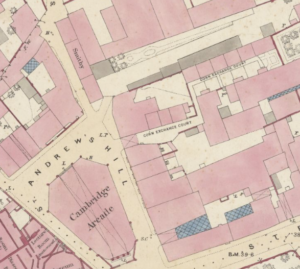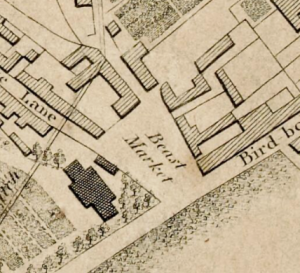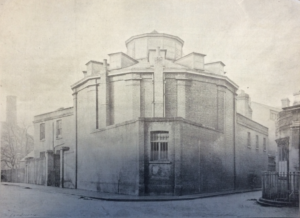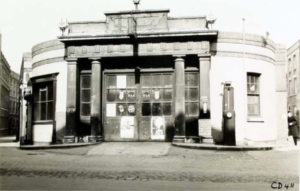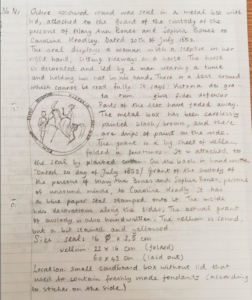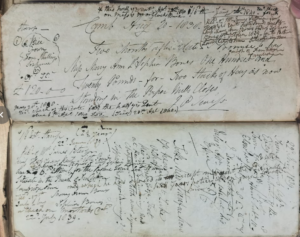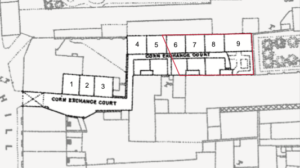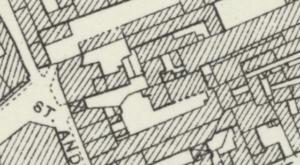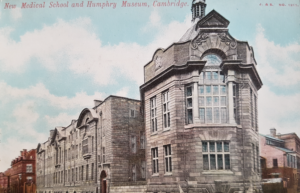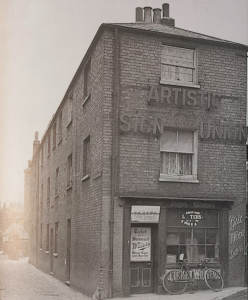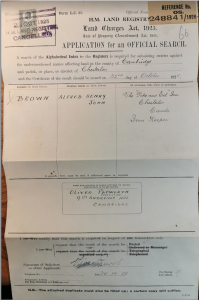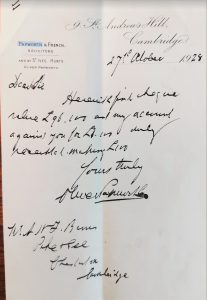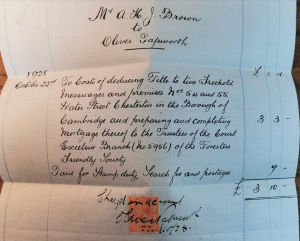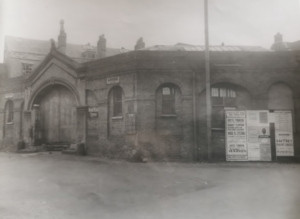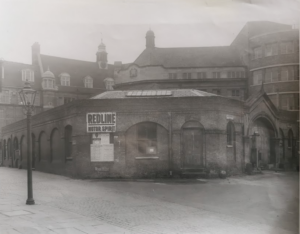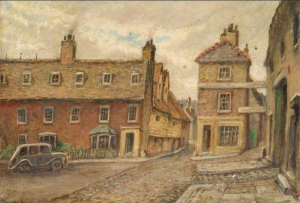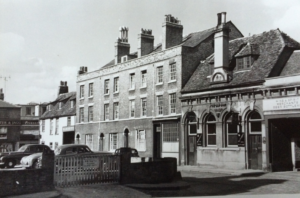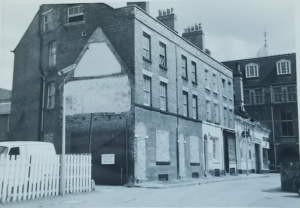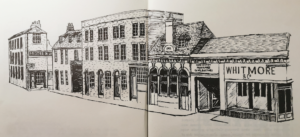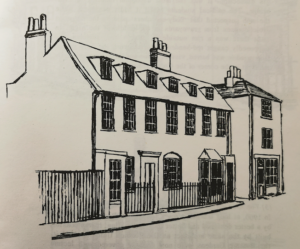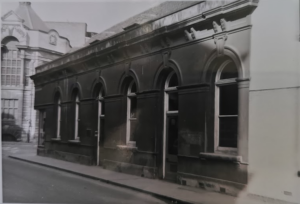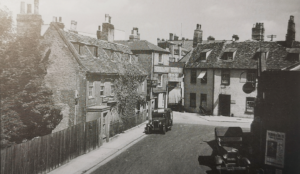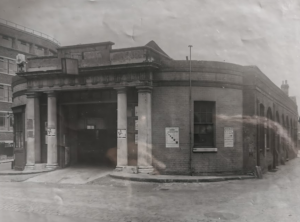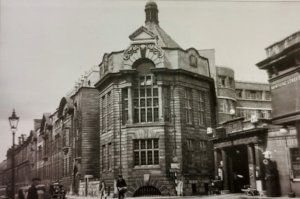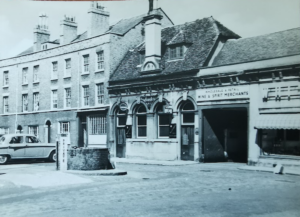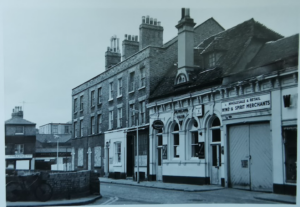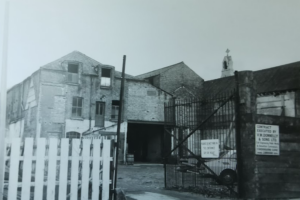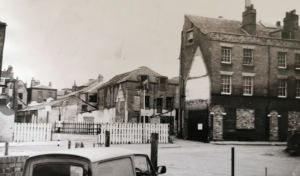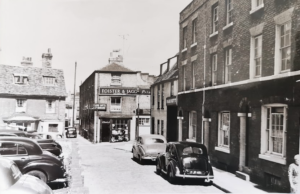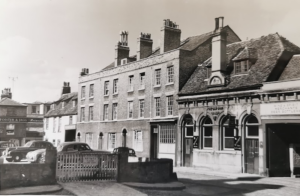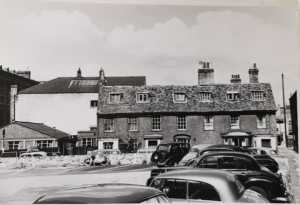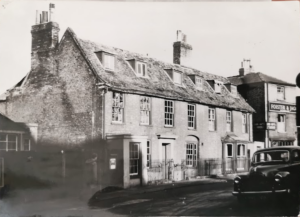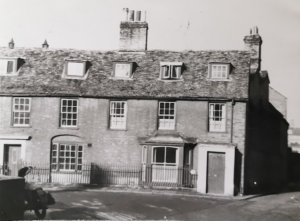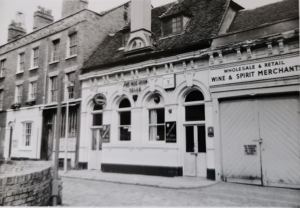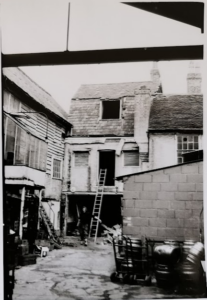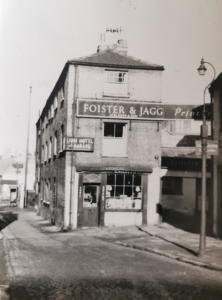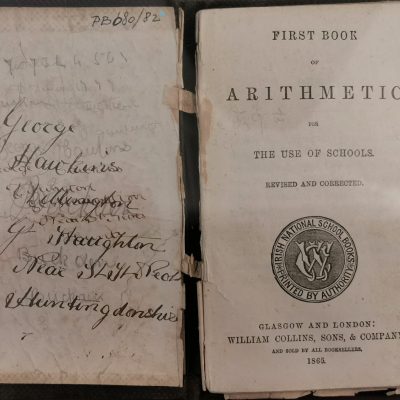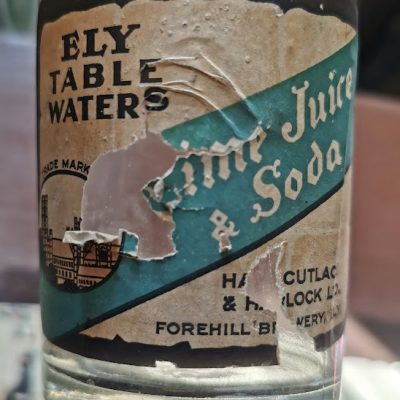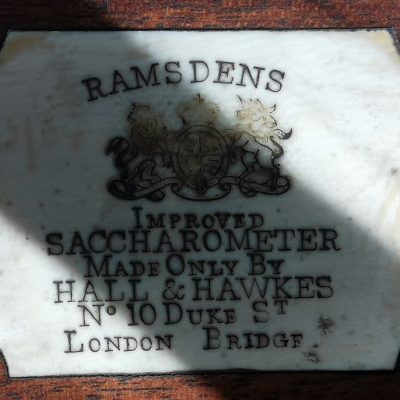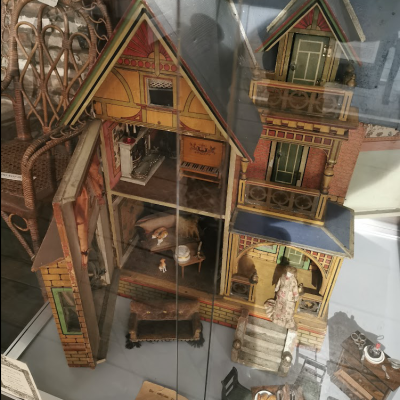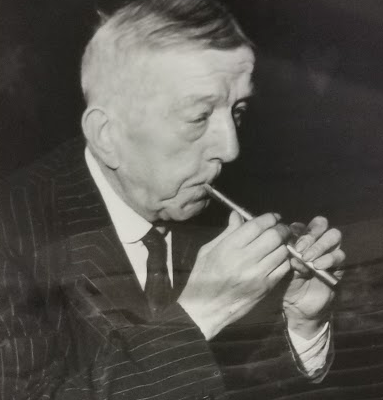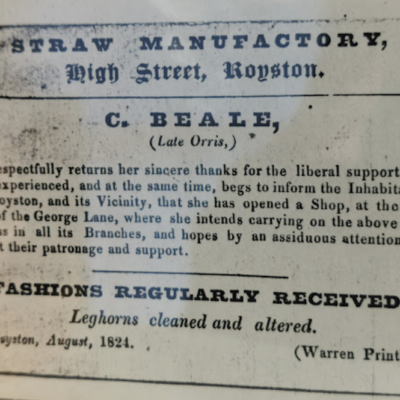Search by topic
- archaeology
- Building of Local Interest
- charity
- church
- crime
- dressmaker
- fire
- Great Eastern Railway
- Listed building
- Mapping Relief
- medieval
- oral history
- poverty
- Public House
- Rattee & Kett
- Religious House
- Roman
- scholar
- school
- Then and Now
- tudor
- women
- work
- world war one
- world war two
Search by text
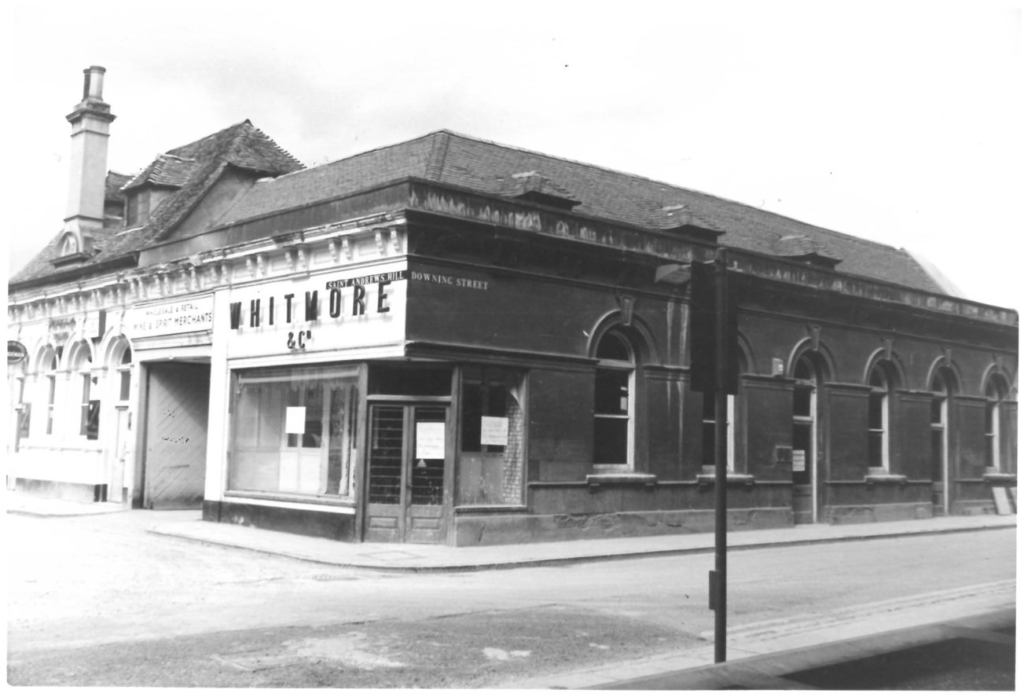 St Andrew's Hill corner with Downing Street c1960 (MoC127.72)
St Andrew's Hill corner with Downing Street c1960 (MoC127.72)St Andrew’s Hill (Hog Hill) (Beast Market), Old Corn Exchange, Corn Exchange Court
History of St Andrew's Hill
St Andrew’s Hill had vanished under the Grand Arcade complex by the end of the 20th century.
It originally ran from opposite the Geological Museum in Downing Street NNW until it joined with St Tibb’s Row which continue almost due north towards the site of the old Post Office.
1959 Royal Commission on Historical Monuments Survey of Cambridge:
House no. 4 and shop no.3 and warehouse adjoining on the south, the last behind the premises of Messrs Barrett and Son, china and glass dealers, 25 St Andrew’s Street, the three forming a domestic’s and business unity…… Barrett’s warehouses in Jesus Lane were offered for sale as building materials in 1831 and R Barrett was ‘of St Andrew’s Hill’ in 1836. Probably therefore the present group was built c. 1830.
House no.7 …. was built in the 18th or early in the 19th century…
Houses, nos. 9 and 10, on the corner of Tibb’s Row and extending towards Corn Exchange Street …. the plan suggests a 16th-century origin. the earliest of the additions to the W is of c. 1700. The wing, probably once a separate building, is of the 17th century. The whole was remodelled and the main range refronted early in the 19th century, probably by Charles Humfrey and in 1818 when the ownership of the land on which two porches were being built was in dispute. Humfrey evidently established his right, for the porches survive and the space between them is enclosed by railings.
The Grand Arcade excavation report (2019) p.291 has some very interesting commentary on the Plot XXII which lay behind nos. 22-26 St Andrew’s Street and fronted onto St Andrew’s Hill.
Throughout the medieval and post-medieval periods Plot XXII had remained a largely open area. This began to change in the late seventeenth and eighteenth centuries (see above), but it was in the nineteenth century that this situation altered fundamentally and Plot XXII became one of the most archaeologically ‘active’ areas in the street block. This was primarily because its lack of earlier development meant that when pressures on space increased during the nineteenth century it presented a significant opportunity, paralleled only by the large garden area that was developed by Robert Sayle (below). The Purchas family continued to own at least part of Plot XXII until 1829, although their fortunes were in decline, and by 1830 the plot was rather more densely built-upon than in the late eighteenth century but not fundamentally altered. The only archaeological feature of c. 1800–30 was brick-lined Well 55. The plot then came into the hands of two local spinsters, Misses Mary Ann and Sophia Bones, who died at some point between 1841 and 1851. In c. 1830–45 and probably c. 1844–5 the area was transformed, and although the Cock Inn continued to exist it shrank and lay outside the investigated area. It is unclear whether this change took place under the aegis of the Bones sisters, although it is perhaps more likely that it took place under their successors who may have been the Barrett family.
See also 25 St Andrew’s Street.
1665
Samuel Newton recorded in his diary, 3 April 1665, seeing a comet at three in the morning as he was rising early to go to Hog’s Hill.
1832
The Dissecting Room of the Medical School was built by Charles Humfrey in 1832 …… the Lantern on top lit the table on which the lecturer demonstrated his dissection. …. In 1834 there was a riot outside it after a body snatcher was supposedly caught re-handed. After the riot, the only ground floor window was barred. Tp the right is the corner of the Corn Exchange.
1842:
The Corn Exchange was in use for 34 years when a much large one was built behind the Guildhall. It then became a small shopping centre of 20 shops. In 1894 the shops were forced to close by a ‘Depression. For two years it was a theatre, then from 1896 to 1914 it was a bicycle shop. After WWI it became a garage, as shown in the photo, until its destruction in 1961 for a Police Car park.
1843:
7 St Andrew’s Hill
Romilly records in his diary 4 July 1843:
M.L. and I went over the two dilapidated houses, gardens and 6 cottages belonging to 2 unfortunate maiden Ladies of the name of Bones who have just been removed to Bedford Asylum. Their relation (Mr Michael Headly) kindly showed us over the place: it was a melancholy exhibition: the 6 cottages were all dismantled, the gardens become a wilderness: the house in St Andrews St had never been finished, they having quarrelled with their Architect:- the house facing the Pig market was where they lived. They fancied everything was poisoned: they used to throw aside their bread after smelling to it: we saw at least 60 loaves of bread in different closets, many wrapped up in paper an dated, the greater part mouldy and hard: they had fastened down the register to their stove, tying it to the top bar, because they thought there were spies in the chimney: they did not venture to speak to each other lest they be overheard by the spies, but wrote down their thoughts on slates: they slept in the same bed: they spoke to persons from a pannel in the bedroom window: they had no servant but an occasional charwoman; they had had not changed their linen for weeks nor see the said charwoman: the elder of the 2 sisters had more than £1000 about her when taken away: they resisted very much (as might be expected) when taken away, and fled from room to room: their little dog defended them stoutly and bit the Policeman. The house and cottages that were unoccupied would let for more than £150 p.a.” in one of the gardens was the old decayed chaise of their Father (an Attorney) ….. [John Bones died in 1813 and is commemorated in a memorial tablet on the north wall of Great St Andrew’s Church.]
The story of these two sisters who lived at 7 St Andrew’s Hill was retold by Enid Porter in the Cambridge News of 31 January and 7 February 1964.
The Museum of Cambridge holds the following items:
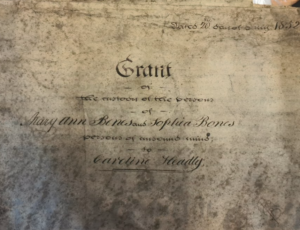
1852: Grant of the custom of the persons of Mary Ann Bones and Sophia Bones persons of unsound mind to Caroline Headly
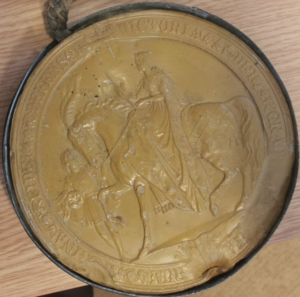
1852: Grant of the custom of the persons of Mary Ann Bones and Sophia Bones persons of unsound mind to Caroline Headly
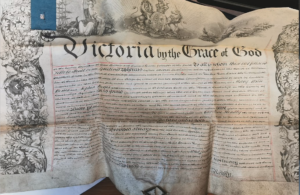
1852: Grant of the custom of the persons of Mary Ann Bones and Sophia Bones persons of unsound mind to Caroline Headly
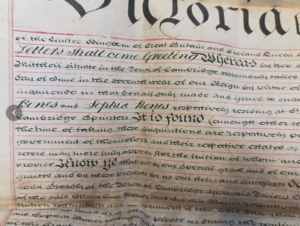
1852: Grant of the custom of the persons of Mary Ann Bones and Sophia Bones persons of unsound mind to Caroline Headly
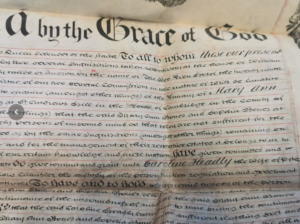
1852: Grant of the custom of the persons of Mary Ann Bones and Sophia Bones persons of unsound mind to Caroline Headly
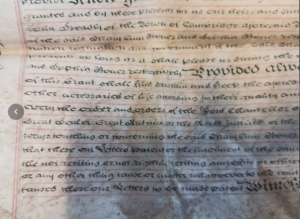
1852: Grant of the custom of the persons of Mary Ann Bones and Sophia Bones persons of unsound mind to Caroline Headly
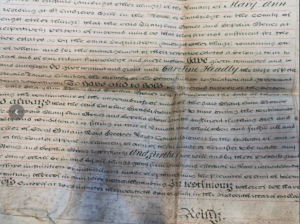
1852: Grant of the custom of the persons of Mary Ann Bones and Sophia Bones persons of unsound mind to Caroline Headly
The Grand Arcade report (2019) p.291describes the archaeological significance of the work that was carried out in the 1840s:
The first stage in the construction of Corn Exchange Court was the demolition of the existing above ground structures and the backfilling of various features including Cellar 4. This feature contained one of the largest and most diverse nineteenth-century assemblages from the site (MNI 290, or 343 if shellfish are included), which is linked to an inn as well as several Colleges. As this material has been published in detail elsewhere (Cessford 2014a), only an overview will be presented here. The backfilling of Cellar 4 involved the dumping of c. 3.1 cubic m of material. The primary constituent of the infill was building debris, consisting of crushed mortar and hundreds of brick and tile fragments, some of which were of the same fabric as the walls of the cellar while others appear to derive from the demolition of different structures elsewhere on the plot. There was also a considerable quantity of ash, charcoal and cinder. The material culture that was recovered was dominated by pottery (MNI 205), plus glass vessels (MNI 13), bone (46 MNBU, plus 5 others) and edible shellfish (MNI 193), plus some clay tobacco pipes (MNI 10), a small amount of window glass, some heavily corroded and unidentifiable iron fragments plus the iron portion of the heel of a shoe, part of a ceramic figurine, two bone knife handles, a whetstone, a small bone button and four copper alloy objects.
Despite the plot’s known association with the Cock Inn relatively few items were recovered that appear to be inn-related. The most obvious was a half pint capacity stoneware tankard-shaped jug with a pinched spout and an ale measure mark consisting of a crown over the initials WR. This was in compliance with the act for ascertaining the measures for retailing ale and beer of 1700, which covered vessels of up to a quart capacity used in inns and other commercial establishments and was in force until 1876 (Bimson 1970).
1844
Corn Exchange Court created.
1851 census
(unnumbered) Charles Henry Careless, 30, college servant, b Hampshire
Emily E, 28, b Essex
Robert, 3, b Middlesex
Annie Jane Flora, 1, b Cambridge
Mary Dawson, 18, servant, b Elsworth
Ellen Wishey, 16, servant, b Cambridge
William W Haggis, lodger, 24, college cook, b Cambridge
Charles Henry died July 1854 aged 34. He was son of James Careless.
1861
(1) Whitesmith shop
(2) Andrew Phillips, 59, innkeeper, b Essex
(3 & 4) Robert Barrett, 34, china dealer, b Ely
(5) Mary Ann Kitteridge, 42, inn keeper, b Cambridge
(6) vacant
(7) Richard Wilson, 49, clergyman no cure private tutor, b Yorks
(8) shop
(9) Arthur C Barrett, 44, private tutor, b Suffolk
(10) Harriett A D Thorn, 40, school mistress, b Southend Essex
(11) Charles Warland, 39, cellarman, b Cottenham
(12) Martha Scarr, 46, sempstress, b Essex
(13) Elizabeth Adson, 50, grocer, b Northants
Exchange Court:
(1) John Cook, 55, dealer in books, b Gamlingay
(2)
Peter Rawe, 30, groom, b Newmarket
Anne Rawe, 35, b Waterbeach
(3) to let
(4) Thomas Edwards, 26, college servant, b Cambridge
(5) Mary Ann Hyde, 23, dress maker, b Cambridge
(6) Frederick Nunn, 41, omnibus driver, b Wood Ditton
(7) James Claver, 33, flyman, b Pampisford
(8) Susannah Rowton, 40, school mistress, b Cambridge
(9) Henry Sauter, 27, ????, b Norfolk
1876
A rollerskating rink was opened in the old Corn Exchange.
1880s
By 1887 the rear portion of Corn Exchange Court had ceased to be used as residential premises and had become a horse stables.
1890s
Enid Porter writes in Cambridgeshire Customs and Folklore p.248:
For a short time in the 1890s the old Corn Exchange on St Andrew’s Hill, which had been used as a shopping arcade following the opening of the new Corn Exchange in 1874, was used as a theatre known as the Arcadia Entertainment Hall.
In the 1890s the rear of Corn Exchange Court was used by Thomas Newton who had a carpenter, glazier, painter workshop, and William Chapman who was a carpenter and undertaker. The cottages remained but their internal divisions had been removed.
1900
The 1832 Dissecting Room was replaced by a better designed and better looking building which still stands.
1902
The Bun Shop saloon and retail bars was built in 1902 as ‘Vaults’ to serve the labourers on the Downing Site where work started that year.
1911
The workhouse was erected circa 1829 and after the Poor Law reform in 1836 was used for the reception of about 30 married couples and aged women. In 1838 it was bought by a shoeing smith.
1913: Kellys (from Downing Street end)
Old Corn Exchange Building;
Foster & Jagg, printers and publishers
Henry Liddiard, cycle and motor depot
East Side:
(1) Whitmore and Co, wine spirit and ale merchants
The Bun Shop saloon and retail bars
(3) R Barrett and Son, earthenware, china, glass and hardware merchants
(4) Herbert Dye Froment, head porter Clare College
(5) Mrs L Hobson, lodging house keeper
(6) Albert Edward Hunting, carpenter
Mrs E Hunting, lodging house keeper
Corn Exchange Court:
Barrett and Son, china, earthenware and hardware merchants
Barrett’s Cottages:
Stables: Knaster and Cox motor garage
(7) Cox and Allen, bookbinders etc
A Cox, advertising agent
(8) Summers and Sons, motor builders
Stable and warehouse, Flack and Judge Artistic Sign Union
West Side:
(9) Papworth and French solicitors
Major Oliver Papworth, councillor of the Borough
North Side:
(9) Frederic W French, secretary Victoria Friendly Societies’ Asylum
Percy Albert French
(10) Mrs Elizabeth Scott
1918
(10) Mrs Elizabeth Starr Scott was reported to have died November 1918 aged 88.
The Lion Yard by Henry Bosanquet (1974) notes the following on this illustration based on the above photo:
On the corner is “the Bun Shop”, dated on the chimney. Next is an early 19th century terrace of four houses, of special interest because of the original shop front in one. All four were ‘listed’ historic buildings.These were the best dwelling-houses to be built on St Andrew’s Hill. …. The houses looked west over the beautiful University Botanic gardens, to the south was the large Swinecroft Common. On the hill itself the the beast market was held – its ancient name was ‘Hog Hill.’….. But in the early 19th century the two sided ‘square’ began to go downhill. In the 1820s the Parish Workhouse was built, the long range with the Foister’s sign.
This 18th century terrace (two listed buildings) was one of the finest examples of its kind in Cambridge. It was the home of Humfrey, carpenter to King’s College in the 1760s. Cambridge’s greatest Regency architect, Charles Humfrey, was born here. He added the door to the left to ‘modernize’ his father’s house. After 1803 it looked down the fine avenue of lime trees, planted by Downing College as a grand entrance. This avenue was destroyed after 1900, when Downing College’s grounds were sold to the University for lecture rooms, after a senior don of the college had run off with college funds.
1937
EAST SIDE
(1) Whitmore & Co, wine and spirit merchants
(3) Warwick S and Son, fine art dealers
(4) Barrett and Son, china and glass dealers
CORN EXCHANGE COURT
(7) Cox and Allen, bookbinders; Foister and Jagg printers; Cambridge Town Football Club (H.H. Neve sec.)
(8a) Daniel Wilsher, boot repairer
NORTH SIDE
Truman and Knightly Ltd, scholastic agents
On the right is the rear of the old Corn Exchange. It was used as a shopping centre until 1884. When this failed, Ernie Hayward opened it as a music hall. It then became a garage. (Vanishing Cambridge, Mike Petty)
1939
1962: Kellys (from Downing Street end)
East Side:
(1) The Bun Shop
(3) Barrett and Son, wholesale and retail glass
(4) Miss Dodd
(5) Mrs L Hobson
Corn Exchange Court:
Barrett and Son, wholesale and retail glass, china and hardware
(7) W S Thatcher, private tutor
(7) Elias and Co stock brokers
A Sidney Campkin and Sons, photographic apparatus
Matthew and Son Ltd
(8a) Speedy Shoe Repair

8 St Andrew’s Hill, Cosimo’s Italian Cafe (former workhouse)(MoC39/69) The reverse of the photo says that this was the site of St Andrew’s workhouse.
Contribute
Do you have any information about the people or places in this article? If so, then please let us know using the Contact page or by emailing capturingcambridge@
License
This work is licensed under CC BY-NC-SA 4.0





